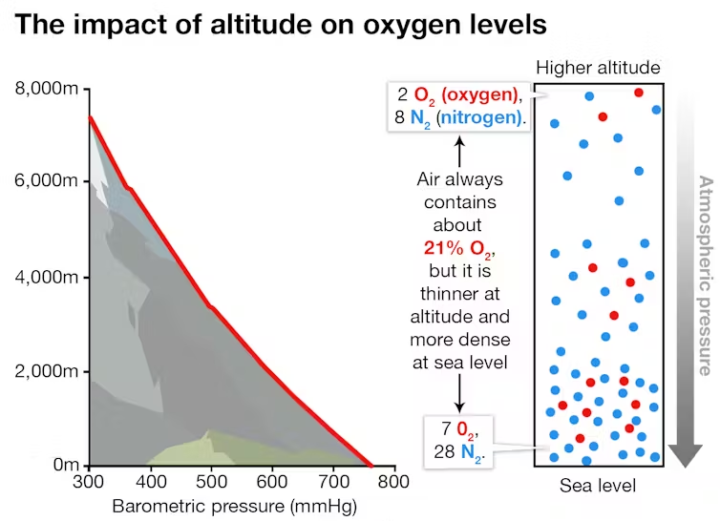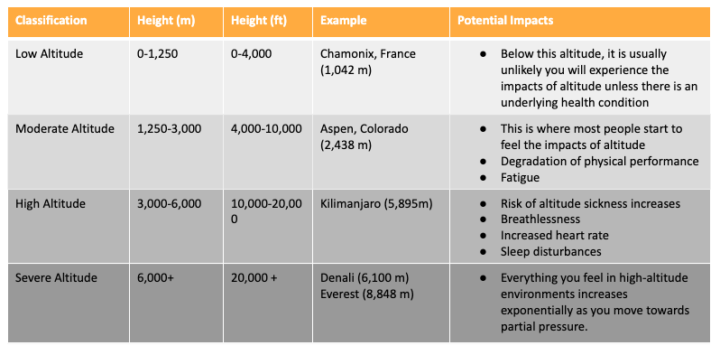Understanding Acclimatization & High-Altitude Environments: Part I
Proper acclimatization during a mountaineering expedition is crucial for the safety and success of all climbers at high altitudes. Acclimatization refers to the process of gradually adjusting to the reduced oxygen levels and harsh environmental conditions encountered at high elevations.

When we start looking at acclimatization and high-altitude environments, it’s important to understand how atmospheric pressure impacts the availability of oxygen at various altitudes. As you increase in altitude, the atmospheric pressure starts to decrease. Because of this, the air is thinner, but it still has about 21% oxygen present, which is the same percentage at sea level. The lower atmospheric pressure means that there is less oxygen available for uptake, which means your blood oxygen saturation (SpO2) will be impacted.
SpO2, or oxygen saturation, is a percentage that measures the amount of oxygen-carrying hemoglobin in the blood compared to the amount of hemoglobin that does not carry oxygen. At about 1,500m (5,000ft), chemoreceptors sense low oxygen pressure, triggering hypoxia (an oxygen deficiency in the body) and a variety of physiological reactions in your body, including the production of more hemoglobin, which thickens the blood.
Classification of Altitudes
It can be helpful to better understand how altitude can potentially affect the body at various altitudes, especially if you are just getting started with mountaineering and aren’t sure what to expect. It’s important to keep in mind that everyone responds differently to high altitudes, and each time you go to a high altitude, your body will respond differently. Just because you didn’t have any issues on Kilimanjaro doesn’t mean you won’t have problems on Aconcagua. The environment you are in and where you are located on the globe all play a role in acclimatization.

High-Altitude Physiological Impacts
The body undergoes several physiological changes to cope with the decreased oxygen availability and other environmental stressors. These adaptations occur over a period of days to weeks and help improve oxygen uptake and delivery to your tissues. Here are some of the key physiological changes that take place during acclimatization:
- Increased Breathing and Depth: One of the primary responses to high altitude is an increase in breathing rate and depth (ventilation). This helps to compensate for the reduced oxygen pressure in the air, allowing for greater oxygen intake and delivery to the bloodstream.
- Increased Heart Rate: Acclimatization will impact both resting and active heart rates to maintain cardiac output and blood pressure in response to the lower oxygen levels at altitude.
- Increased Urination: Acclimatization may involve changes in fluid balance, including increased urine output and changes in electrolyte levels, to help regulate blood volume and blood pressure at high altitudes.
- Blood Changes: To enhance oxygen transport, the body increases the production of red blood cells in response to hypoxia. This occurs primarily in the bone marrow, stimulated by the release of erythropoietin (EPO) from the kidneys. Higher red blood cell counts improve the blood’s oxygen-carrying capacity.
- Muscle Changes: With acclimatization, muscles may become more efficient at utilizing available oxygen. This adaptation helps to maintain physical performance at high altitudes despite reduced oxygen availability.
These physiological adaptations allow the body to function more effectively in low-oxygen environments and mitigate the negative effects of altitude on physical performance and well-being. Your body is doing some pretty cool things while you acclimate to allow you to reach the summit in good style. You will hear us press this issue over and over again: it’s incredibly important to remember that individual responses to altitude vary, and not everyone acclimatizes at the same rate or to the same extent. Some of the best climbers in the world need to allow more time for their bodies to adapt to altitude.
Importance of Acclimatization
Acclimatized climbers generally experience less discomfort and distress at high altitudes, allowing them to enjoy the experience of mountaineering more fully, recover more quickly, stave off altitude sickness, and increase overall physical performance. Here is a quick look at why it’s so important to acclimatize properly.
- Improved Physical Performance: Acclimatization allows the body to adapt to the reduced oxygen availability, which enhances physical performance at high altitudes. Climbers who acclimatize properly are better able to maintain strength, endurance, and mental clarity, which are essential for safe and successful ascents.
- Increased Oxygen Uptake: With acclimatization, the body increases its production of red blood cells and improves oxygen uptake efficiency by the muscles and tissues. This adaptation helps maintain adequate oxygen delivery to vital organs, reducing the risk of hypoxia and its associated symptoms.
- Better Temperature Regulation: High altitudes often come with extreme temperature variations, including intense sunlight during the day and freezing temperatures at night. Acclimatization allows the body to better regulate its temperature, reducing the risk of hypothermia or heat-related illnesses.
- Reduced Risk of Exhaustion and Injury: Climbers who are properly acclimatized are less likely to experience fatigue, exhaustion, or impaired judgment, reducing the risk of accidents and injuries on the mountain.
Prevention of Altitude Sickness: Acclimatization helps the body cope with the lower oxygen levels present at high altitudes. Without proper acclimatization, climbers are at risk of developing acute mountain sickness (AMS), which can range from mild symptoms like headaches and nausea to more severe conditions like high altitude pulmonary edema (HAPE) or high altitude cerebral edema (HACE).
Altitude Illnesses
As we’ve shared, high-altitude environments impact the body in a variety of ways due to the decrease in atmospheric pressure and oxygen availability as altitude increases. When you do not acclimatize properly, you put yourself at risk of developing altitude sickness, including acute mountain sickness (AMS) and high altitude cerebral edema (HACE), which sit on a continuum of altitude sickness together. AMS presents with less severe symptoms, which could progress into HACE. High altitude pulmonary edema (HAPE) doesn’t exist in the same continuum, which means it can happen without additional signs or symptoms of altitude sickness.
- Acute Mountain Sickness: AMS is a common condition experienced by individuals ascending to high altitude too quickly. Symptoms include headache, nausea, vomiting, dizziness, and difficulty sleeping. AMS can range from mild to severe and can affect anyone regardless of fitness level or prior experience.
- High Altitude Cerebral Edema: HACE is another serious altitude-related illness involving swelling of the brain. Symptoms include severe headache, confusion, difficulty walking, hallucinations, and loss of consciousness. HAPE requires immediate descent to lower altitudes and medical intervention.
- High Altitude Pulmonary Edema: HAPE is a potentially life-threatening condition characterized by fluid accumulation in the lungs. Symptoms include severe shortness of breath, coughing up frothy or pink sputum, chest tightness, and blue discoloration of the skin (cyanosis). Like HACE, HAPE requires prompt descent and medical attention.
High altitude environments pose significant challenges to the body, and climbers must take precautions, including gradual acclimatization, proper hydration and nutrition, and recognizing and responding to symptoms of altitude sickness promptly to mitigate these effects and ensure a safe ascent.
Are you looking for some strategies to help you acclimatize properly?
Head to our Understanding Acclimatization and High-Altitude Environments: Part II blog to learn more about pre-acclimatization, on-expedition acclimation strategies, and Speed Ascents offered by CTSS that use Hypoxico Altitude Training Systems. You can also check out our Mountaineering 101: Understanding Acclimatization and High-Altitude webinar!